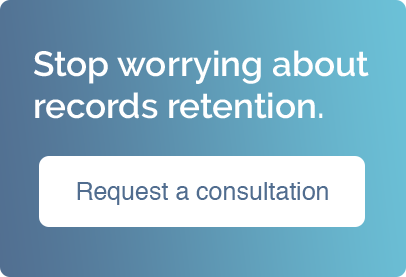3 Steps to Establishing a Record Retention Schedule
Record retention and management is the effective and systematic control of an organization’s records and important documents. When established, a record retention schedule helps to ensure that important and valuable documents evidencing an organization’s activities, and that have legal, fiscal, administrative, or historical value, are protected, stored, and accessible, while documents that are not as important or are useless are systematically destroyed.
Below, we’ve outlined three steps to establishing a retention schedule for those organizations that do not currently have a retention schedule in place. It is important to have an established schedule to protect you and your organization.
1.Establish a team to develop and implement a retention schedule.
When first starting out to develop a retention schedule that will fit the needs of your organization, it is a good idea to start by assigning team members to a team specifically dedicated to establishing the schedule. These team members should each bring unique and valuable insight into the process, and be from various levels of management.
During the initial phases of establishing a retention schedule, the team assigned to the task should identify and develop vision and mission statements for the schedule. The vision statement will describe where the team desires to see the schedule in a few years, while the mission statement describes the purpose of the schedule, who the schedule services, and the plan for achieving the long-term vision of the schedule. Determine what aspects of the process will be handled “in-house”, and what will need to be outsourced to outside vendors and consultants. Once you have a general idea of how the retention schedule will work, you will then be ready to move on to the next step.
2.Take an organization-wide inventory of all the records in your office.
Inventory of an organization’s records will help to identify what information needs to be managed and stored as part of the retention schedule. The inventory should include both physical and electronic documents that your organization has on file. Taking inventory will take time, but it is a helpful step to complete prior to establishing a retention schedule. Inventory will help your organization identify and classify documents in the following categories:
•Records: Any document that your organization either created or received in pursuance of legal obligations or in the transaction of business. Any document that has value requires retention.
•Non-Records: Any material that does not contain valuable information. Non-records may include reference material, personal papers, junk mail, publications, or duplicate copies of documents.
•Vital Records: Any document that will be needed immediately after an emergency in order for your organization to continue operation.
•Archival Records: Historical records of enduring value that are preserved and stored within the organization’s archives.
Inventory of an organization’s documents should include any and all formats that the documents exist in. After getting a feel for the various documents that will need to be inventoried, you’ll then need to determine if you have the resources necessary to conduct the inventory in-house, or if it would be in your best interest to hire a consultant to perform the inventory of documents.
3.Establish your organization’s record management policy and procedures and implement your schedule.
When establishing the policies and procedures for the retention schedule, there are a few key elements that should be included in the policies:
•Define responsibilities: Record management responsibilities should be assigned to various employees of the organization. Employees that should be included are the executive sponsor of the program, steering committee, records management and information technology staff, business unit managers, system administrators, record coordinators, and general users.
•Organization’s definition of “record”.
•Where records will be kept.
•Record retention and disposition procedures.
The retention schedule that is customized to your organization should meet all of your organization’s unique needs, to ensure that all essential records are retained only as long as required, based on documented research of legal, fiscal, administrative, and historical requirements. Unnecessarily holding on to documents may increase an organization’s liability of what is contained within the documents.
It is important for each organization to have its own personalized record retention schedule to meet its unique needs. Whether you are prepared to undertake the task of establishing one on your own, or require the assistance of a professional consultant, Information Requirements Clearinghouse has consultants and programs established to help you get the retention schedule that will be the most beneficial to your organization. Contact us today to learn how we can help you get your records retention schedule established.

